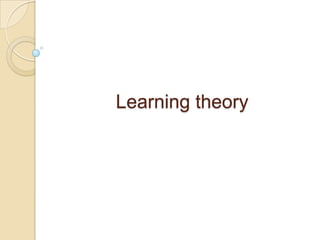
Learning theory
- 2. what is Learning A change in behavior resulting from repeated practice
- 4. Classic conditioning The Russian physiologist and Nobel Prize winner Ivan Petrovich Pavlov(1849-1936) learning to associate two stimuli such that one stimulus comes to produce a response that originally was only produced by the other stimulus
- 5. Pavlov discovered that when a stimulus is associated with food, dogs will learn to associate the stimulus with food, and will salivate
- 6. ◦ Before conditioning: Tone > No salivation Food (UCS) > Salivation (UCR) ◦ During conditioning: Tone (CS) + Food (UCS) > Salivation (UCR) ◦ After conditioning: Tone (CS) > Salivation (CR)
- 9. Operant Conditioning type of learning in which behavior is influenced by its consequences
- 10. B. F. Skinner viewed operant conditioning as form of natural selection that facilitates personal adaptation ◦ Skinner box – box with lever that, if pulled, drops food into cup ◦ Skinner found that rat will press bar more frequently over time
- 11. Several important types of consequences ◦ Reinforcement – response is strengthened by an outcome that follows it Caused by reinforcer (such as food) ◦ Punishment – response is weakened by an outcome that follows it Caused by punisher (electric shock)
- 14. Discriminative stimulus signal that a particular response will produce certain consequences (e.g. a light that would signal the rat to pull the lever, but if no light was on, no food would come out)
- 15. Positive reinforcement ◦ Primary reinforcer – stimuli that an organism finds reinforcing due to biological needs (e.g. water or food) ◦ Secondary/Conditioned reinforcer – stimuli that acquires reinforcing qualities by being associated with a primary reinforcer (e.g. money)
- 16. Negative reinforcement – a response is strengthened by the removal or avoidance of a stimulus (negative reinforcer) Operant extinction – the weakening and eventual disappearance of a response because it is no longer reinforced ◦ Resistance to extinction notes the degree to which non-reinforced responses persist
- 17. Positive punishment – a response is weakened by the presentation of a stimulus ◦ Often produces rapid results ◦ Suppression may not generalize to relevant situations Negative punishment – a response is weakened by the removal of a stimulus Reinforcement or punishment that occurs immediately after behaviour has a stronger effect than when delayed ◦ Delay of gratification – the ability to forego an immediate but smaller reward for a delayed by more satisfying outcome
- 18. Shaping – reinforcing successive approximations toward a final response ◦ Example: To get a child to be active when he usually sits and does nothing, first reward him every time he gets up, then only when he walks towards something active, then only once he does something active
- 20. Chaining – reinforcing each response with the opportunity to perform the next response ◦ Example” At first the rat learns to press a lever when it sees a light, but after accidentally hitting a bell nearby that turns the light on, the rat will learn to ring the bell
- 21. Operant generalization – an operant response occurs to a new stimulus or situation that is similar to the original Operant discrimination – an operant response will occur to one stimulus, but not another
- 22. Continuous reinforcement – every response of a particular type is reinforced Partial reinforcement – only some responses are reinforced
- 23. ◦ Ratio schedules are based on a certain percentage of reinforced responses Fixed ratio schedule – reinforcement is given after a fixed number of responses (e.g. food after three pulls of lever) Variable ratio schedule – reinforcement is given after a variable number of correct responses, all centered around an average (e.g. slot machine pays on average every 20 pulls)
- 24. ◦ Interval schedules are based on a certain amount of time elapsing between reinforcements Fixed interval schedule – first correct response that occurs after a fixed time interval is reinforced (e.g. food only on first pull of lever every 20 minutes) Variable interval schedule - reinforcement is given for the first response that occurs after a variable time interval (e.g. quizzes about every 2 weeks)
- 25. Partial reinforcement is learned slower, but more resistant to extinction (especially on variable schedule) ◦ Takes longer to realize that variably reinforced responses are not occurring
- 26. Social learning theory Relies on role modeling Identiication Human interaction
- 27. thanks